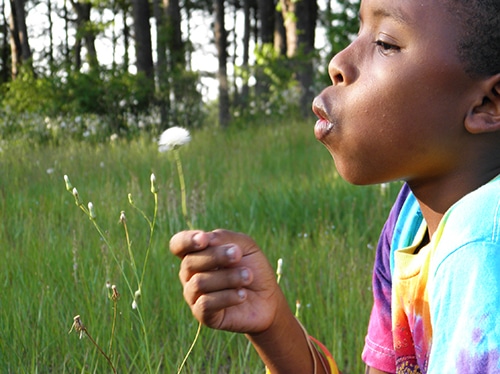How the Cowichan Regional Airshed Roundtable used evidence and shared leadership to address air quality improvement in the region.
THE OPPORTUNITY
The Cowichan Valley Regional district historically has a strong reliance on the forest sector and wood burning for home heating, clearing land and traditional practices. The Region’s history of burning and nature of its topography has led to having some of the poorest air quality in BC.i
Today, the region’s rates of childhood hospitalizations for respiratory issues are 70% higher than the BC average, and chronic respiratory illness for adults 45 and older is 50% higher. Addressing air quality was named as one of nine priorities in the Cowichan Communities Health Profile in 2014. Of most concern is the fine particulate matter that comes from wood burning.iii
This issue of poor air quality is complicated by the fact that there are multiple authorities with different jurisdictions related to air quality. There is no one body that can tackle it. The challenge then is how, in the face of historical attachment to wood burning, growing public health issues and multiple authorities and roles, can the communities begin to address this issue?
The Cowichan Valley Regional District (83,739 peopleii) sits between Nanaimo and Victoria on Vancouver Island and is home to the communities of Duncan, Ladysmith, Chemainus, North Cowichan, the Cowichan Tribes (BC’s largest First Nations Band) and several other First Nations communities.

Cindy Lise, the Regional Facilitator for Our Cowichan Communities Health Network says, “Air quality planning requires collaboration as all partners have a variety of reasons for why they burn including historical practices, land clearing, heating, and cultural practices. Starting by understanding the complex reasons why burning takes place moves us toward collaboration and innovation when it comes to impacting burning practices.”
The Cowichan Regional Air Shed Roundtable was formed as an opportunity to address the complex issue of air quality in a collaborative, systemic way. The Roundtable includes an Island Health Medical Health Officer and representatives from government agencies, including Ministry of Environment, First Nations’ governments, industry and non-government organizations. They are collaboratively working to identify air quality issues, identify specific goals, actions and key organizations to do the work that can improve regional air quality.
Teaming up with the Cowichan Valley Regional District (CVRD) and with facilitation from Our Cowichan Health Network, the Roundtable presented evidence-based research to the public. Careful facilitation and input over two-years resulted in an air protection strategy. The strategy, published and endorsed by multiple partners in 2015, has two main goals; protect human health and build strong collaboration.
CREATING CONDITIONS FOR INNOVATION
Meeting regularly and creating a strategy was a significant achievement, however, there were different opinions among round-table members about how to reduce fine particle (PM2.5iv) emissions and the roles of stakeholders.
The CVRD took a lead role in development of the strategy but needed community ownership to take action. CVRD Chair Jon Lefebure said, “Given this is an area in which many players are involved, the CVRD has taken the lead role in the development of the strategy in coordination with the Ministry of Environment. However the implementation will require a broad and coordinated response from many”.
The partners knew that if they wanted to strengthen community ownership and implement the airshed strategy to grow their impact, they needed to move beyond the sharing information at meetings and collaborate differently.
Our Cowichan Health Network became the steward of the Regional Airshed Roundtable and is responsible for bringing the community partners together for dialogue and planning. It is hoped that the roundtable can help the Medical Health Officer move agendas forward.
The Roundtable decided to embark on a collaborative leadership journey through the PlanH Growing Impact program. Growing Impact is a healthy communities learning and leadership process facilitated by BC Healthy Communities (BCHC). They participated in a two-day learning session in addition to receiving coaching and developing an online community of learning and practice.

The group identified that their efforts were focused on structures and rules, such as regulatory interventions. They had not considered other personal perspectives, such as why people continued to burn wood. The BCHC facilitators provided tools for creating collaborative structures and open dialogue. The group adopted practices such as opening and closing exercises and a shared set of rules for collaboration.
They began to see the different perspectives on wood burning as a leverage point, rather than a tension point. They had new ideas about how to support a culture of diversity and acceptance. For example, partners are using neighbourhood-level air quality data to identify ’hot spots’ where air quality is a concern. They share the data with people contributing to the ‘hot spot’ to encourage open dialogue.
IMPACT TO DATE
The Roundtable formed three working groups: Engagement & Awareness, Open Burning and Monitoring & Evaluation. Community members participate in the working groups and are building awareness and engagement with communities.
One participant said, “We are more organized for action with a leadership team, roundtable and working groups, each having defined roles and responsibilities. To enable our discussion, we have applied some of the tools (e.g. Integral framework’s four quadrants exercise) at our Airshed Roundtable and leadership group meetings this year.”
“We are more organized for action with a leadership team, roundtable and working groups, each having defined roles and responsibilities.” – Cowichan Regional Airshed Roundtable and Growing Impact Cohort participant
The Cowichan region has seen air quality improve in 2016 as a result of a number of factors including fewer atmospheric conditions that impact air quality, fewer environmental challenges such as forest fires as well as the community’s combined efforts. It will only be due to monitoring the airshed and reviewing the data over a period of time that the results of the airshed strategy will be known.
LESSONS LEARNED
Group members talk about how affirming it was to hear that “collaboration moves at the speed of relationships and trust”. They left the Growing Impact Training with a new patience for the time it takes to create trust, and strategies for being intentional about supporting a collaborative culture.
Members are taking action and continue to plan strategically. They feel it is important to plan and act at the same time by starting with a simple, small project, as a project tends to engage and energize people in ways that planning on its own does not. The BCHC facilitators’ call this approach ‘action research’.
The neighbourhood air sensor network is one example of action research. Purple air monitors will be distributed around the region in the fall of 2017 to collect neighbourhood level data. This project is combined with an awareness campaign and community engagement about better burning and how everyone’s actions impact those around them.
The partners talk about the Growing Impact Training as a shared experience that brought them together as a team and gave them new understanding and respect for each other. There is a shared language around systems change and collaboration that shows up at Leadership team meetings.
Although the process took more time from the partners, members note that there is a genuine sense of collaboration at the table that invites different perspectives as part of how they solve problems together. They are seeing first hand the power of collaborative problem solving to people live healthier lives and suffer from less chronic disease.
i Particles smaller than 2.5 micrometers
ii Cowichan Valley Regional District population statistics
iii Cowichan Regional Air Protection Strategy
iv Particles smaller than 2.5 micrometers
Resources
More Information
Our Cowichan Health Network
Cindy Lise, Regional Facilitator
Duncan, British Columbia, Canada
www.ourcchn.ca





